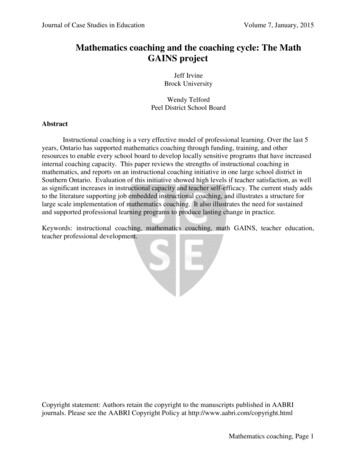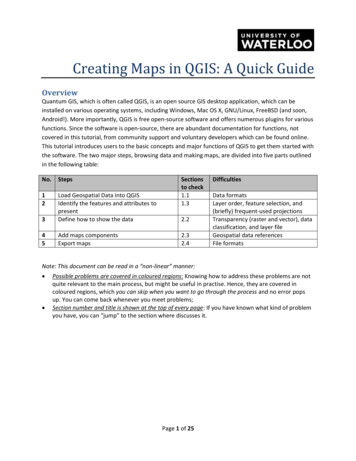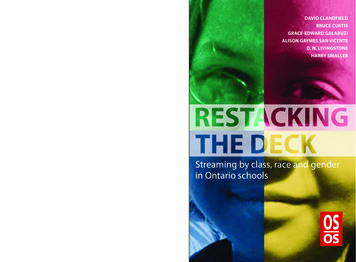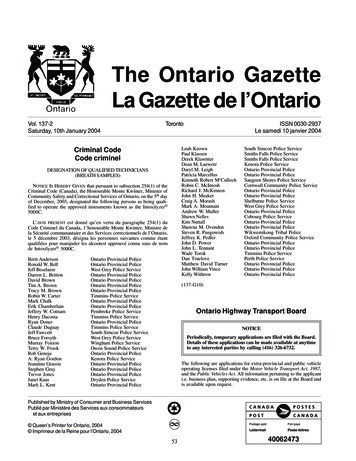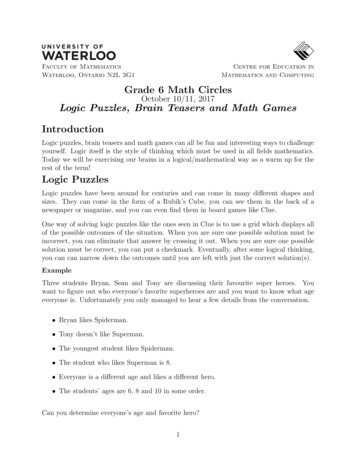
Transcription
Faculty of MathematicsWaterloo, Ontario N2L 3G1Centre for Education inMathematics and ComputingGrade 6 Math CirclesOctober 10/11, 2017Logic Puzzles, Brain Teasers and Math GamesIntroductionLogic puzzles, brain teasers and math games can all be fun and interesting ways to challengeyourself. Logic itself is the style of thinking which must be used in all fields mathematics.Today we will be exercising our brains in a logical/mathematical way as a warm up for therest of the term!Logic PuzzlesLogic puzzles have been around for centuries and can come in many different shapes andsizes. They can come in the form of a Rubik’s Cube, you can see them in the back of anewspaper or magazine, and you can even find them in board games like Clue.One way of solving logic puzzles like the ones seen in Clue is to use a grid which displays allof the possible outcomes of the situation. When you are sure one possible solution must beincorrect, you can eliminate that answer by crossing it out. When you are sure one possiblesolution must be correct, you can put a checkmark. Eventually, after some logical thinking,you can can narrow down the outcomes until you are left with just the correct solution(s).ExampleThree students Bryan, Sean and Tony are discussing their favourite super heroes. Youwant to figure out who everyone’s favorite superheroes are and you want to know what ageeveryone is. Unfortunately you only managed to hear a few details from the conversation. Bryan likes Spiderman. Tony doesn’t like Superman. The youngest student likes Spiderman. The student who likes Superman is 8. Everyone is a different age and likes a different hero. The students’ ages are 6, 8 and 10 in some order.Can you determine everyone’s age and favorite hero?1
SolutionThis question has three categories; name, age and superhero; each one of these having threedifferent possibilities. We can arrange all of these possibilities in a grid which will be verySuperheroes - Logic Gridhelpful in solving this problem.Solve this logic puzzle to find out the name, the age and the favorite superhero of each kid.10 years8 yearsAge6 eanTonyAge6 years8 years10 years1. Bryan likes Spiderman.2. Tony doesn'tlike Superman.The first piece of informationwe weregiven tells us that Bryan likes Spiderman. We know this3. The youngest kid likes Spiderman.is true, so put a checkmarkin the box which tells us whether or not Bryan likes Spiderman.4. The kid who likes Superman is 8.Also, we know that everyone likes a different hero, so neither Sean or Tony like Spiderman.play more logic grids puzzles on Brainzilla.comAdditionally, this also means Bryan does not like Batman or Spiderman. Put crosses todisplay the students’ disliking of the appropriate heroes.The second clue tells us that Tony doesn’t like Superman, so we can cross that off of ourgrid, and the third clue tells us that the youngest student likes Spiderman. The ages of thethree students are 6, 8 and 10, so the 6 year old has to be the one that likes Spiderman.The fourth clue tells us that the student who likes Superman is 8. We can check this off,and again, because everyone has to like a different hero, this allows us to cross out the other2 superhero options for both the 6 and the 8 year old.Superheroes - Logic GridSolve this logic puzzle to find out the name, the age and the favorite superhero of each kid.NamesBryanSean 6 years 8 years 10 years1. Bryan likes Spiderman.2. Tony doesn't like Superman.3. The youngest kid likes Spiderman.4. The kid who likes Superman is 8.2play more logic grids puzzles on Brainzilla.com10 years8 years6 yearsSupermanAge TonyAgeSpidermanBatmanSuperheroes
Looking at the Superman column, you can see that neither Bryan or Tony like him. BecauseSean is the only possible option left, he must be the one who likes Superman. This also allowsus to cross out the other superheroes in Sean’s row because we know he will exclusively likeSuperman.The only superhero yet to be liked is Batman, and the only student whose favourite hero weare yet know is Tony’s. This means Tony must be the one who likes Batman.Finally we know that each student is a different age. The student who likes Spiderman is 6and the student who like Superman is 8. This leaves the student who likes Batman to be10. This is the final piece of information we can deduce from this question, so you can nowfill any remaining boxes with crosses.With the filled grid, you can see that you have the answer to your original question. Bryan is 6 and he likes Spiderman. Sean is 8 and he likes Superman. Tony is 10 and she likes Batman.Superheroes - Logic GridSolve this logic puzzle to find out the name, the age and the favorite superhero of each kid.AgeNamesSean Tony 6 years 8 years 10 years10 years 8 yearsBryanAge 6 yearsSupermanSpidermanBatmanSuperheroes 1. Bryan likes Spiderman.2. Tony doesn't like Superman.3. The youngest kid likes Spiderman.4. The kid who likes Superman is 8.3play more logic grids puzzles on Brainzilla.com
Problems1. Three girls; Angela, Lisa and Susan, met each other on their first day at logic summercamp. For an ice breaker, the girls created a logic grid to help them learn about each other’sfavourite colour, and what kind of pet they have. The camp counsellor who knew all of thegirls’ favourite colours and what pets they have decided to give them these 4 hints: Lisa, whose favourite colour is not green, has a fish. Susan’s favourite colour is red. The girl who likes green also has a dog. None of the girls have the same type of pet or have the same favourite colour.Basic 2 - Logic GridWhat other details can the 3 girls logically deduce about one another?With only three clues, this logic grid is a piece of isaSusanPetscatdogfish1. Lisa, whose favorite color is not green, has a fish.2. Susan's favorite color is red.Angela has aand her favourite colour is.3. The kid who likes green also has a dog.Lisa has aSusan has aand her favourite colour isplay more logic grids puzzles on Brainzilla.comand her favourite colour is4.
2. Amanda, Jack, Mike and Rachel each travelled to a different part of the world in adifferent year. You have been hired to make a scrapbook of their journeys, but you can’tquite remember who went where and in what year. From looking at all of the photos youwere given to put into the scrapbook, you can tell that the following 6 details must be true: Neither Amanda or Jack traveled in 2015. Mike didn’t travel to Rio de Janeiro. Rachel traveled in 2014. Amanda visited London. Neither Mike or Rachel traveled to Tokyo. A man traveled in 2016.Can you make sure you properlylabel theirBasic3 - scrapbook?Logic GridThis logic problem is more complex than the other two because it has more clues and items.TokyoSydneyRio de aNamesJackMikeRachelDestinationLondonRio de JaneiroSydneyTokyo1. Neitherin 2015.Amanda traveledto Amanda nor Jack traveledin theyear.2. Mike didn't travel to South America.Jack traveled3.toRachel traveled in 2014. in the year4. Amanda visited London.Mike traveled to.in the year5. Neither Mike nor Rachel traveled to Japan.6. Atoman traveled in 2016.Rachel traveled.in the yearplay more logic grids puzzles on Brainzilla.com5.
*3. You have been chosen to present awards to four YouTubers: Anthony, Eric, Leonardand Robert at the Teen Choice Awards. The only problem is, you can’t remember all of thedetails about their channels! None of the channels share common properties and: Robert’s channel has 400,000 subscribers. Neither the Irish YouTuber or Leonard have channels about movies. The movies channel has 200,000 subscribers. The science channel has less subscribers than the channel owned by the American. Anthony has a DIY channel. The Australian YouTuber has a channel with 200,000 more subscribers than the sciencechannel.Youtubers - Logic GridCan you use this information to make sure you properly present the four awards?Can you figure out which channel belong to each youtuber and how many subscribers amesMoviesScienceAnthony hasEric has1. Robert's channel has 400,000 subscribers.subscribers on hischannel and is.2. The Irish youtuber and Leonard doesn't have a channel about movies.3. The moviessubscriberschannel has 200,000Robert.on hissubscribers or is owned by channeland is.4. The science channel has less subscribers than the channel owned by the American.Leonard has5. Neither the sciencechannel nor thesubscribersonmovieshis channel has 400,000 subscribers.channeland is.6. Anthony has a DIY channel.Robert hason hiswith 200,000 more subscriberschannelis7. The Australian subscribersyoutuber has a channelthan theandsciencechannel.* Denotes a difficultproblem!play more logic grids puzzles on Brainzilla.com6.
Math Brain TeasersThere are many tricky math questions in the world, but some are tricky for the wrongreasons. Brain teasers are a type of question which may seem simple at first, but their maingoal is to mislead you. See if you can spot the tricks in each of these questions.Example: The Missing Dollar ProblemThree friends were renting a hotel room together which cost 30 a night, so they decided toevenly split the bill and pay 10 each. After they finished paying, the hotel manager realizedthat the room they rented was really meant to only be 25. He went to return the 5 tothe three friends, but he noticed he couldn’t evenly distribute the money between them.Because the three friends did not know about the change in price, the manager decided toonly return 1 to each friend, and he would keep the other 2 for himself.Originally the three friends each payed 10 each, but with the refunded 1, they actuallyonly spent 9 each. Overall that means they spent 27 on the room. The manager kept 2for himself which brings the total up to 29. We started out with 30, so why do we nowonly have 29?SolutionA good way to start this problem is to track the total amount of money during each step ofthe question. 10 101. Each friend has 10. 10 302. The manager receives a 10payment from each friend. 253. The manager keeps 25 to pay forthe room and he goes to return 5 tothe friends. 5 25 1 1 1 24. The manager still has 25 to payfor the room, plus he gives 1 to eachfriend, and keeps 2 for himself.You can see that if you add up the total amount of money during each step, it is always 30.This tells us that there isn’t actually a missing dollar, but instead there must be an errorsomewhere in the question.So what is the error in the question?7
More Tricky Problems (Think Carefully!)1. What is the error in the “Missing Dollar Problem”?2. A certain tree grows in such a way that it doubles in height every year. When it reachesa height of 100 feet tall, the tree will be 38 years old. How old will the tree be when it is 50feet tall?3. If a pencil and an eraser 1.10 together, and the eraser costs 1.00 more than the pencildoes, how much does the pencil cost?4. In a car factory, 6 machines can make 6 wheels in 6 minutes. How long will it take 30machines to make 30 wheels?5. This is a famous problem called the “Monty Hall Problem”, which originally comes fromthe gameshow “Let’s Make a Deal”. Here’s how the problem goes: A gameshow contestant has to choose 1 of 3 doors, and they will receive whatever prizeis hidden behind that door. 2 of the doors contain a “zonk”, a prize that nobody would ever want (like a tennisracket made of glass, or a 10 pound bag of black licorice). The other door has anawesome prize like a new car or a free vacation. Once the contestant chooses their door, the host will eliminate one of the zonks, andthen give the contestant an opportunity to either keep the prize behind the door theychose, or they can switch to the remaining door.The question now is, if they switch to the other door, what are their odds of winning theawesome prize?a) 1/3b) 1/2c) 2/3Before we discuss the correct answers, carefully go through each of these four questions andmake sure your answer makes sense!8
Math GamesThere are thousands of math games which you can find all over the place. Some that youmay be familiar with are sudoku, dots and boxes, chess, Rubik’s cubes, and many manymore. Today we will try a few that you have hopefully never heard of!SujikoSujiko consists of a 3 by 3 grid as well as 4 numbered boxes. The 4 adjacent squaressurrounding each numbered box must have numbers which sum to the value inside the box.Additionally you can only use the numbers 1 to 9, and you must use each number exactlyonce.Hint: A good way to start a Sujiko is to first look at the 4 numbered boxes, and in particular,the boxes with the largest and smallest value. The reason for this is that there are fewercombinations of addition which can add to either very small or very large numbers. (Withfour numbers, how many ways are there to addto 10? How about 30? How about 20?)!Sujiko 2ExampleFill in squares of the grid with the numbers 1 to 9. Numbers can not berepeated and all the numbers 1 to 9 must be used. In addition the sumSolve the following Sujiko!of the numbers in each adjacent group of 4 squares must add up to thenumbers in the rectangles at the intersections of the 4 squares.!!!!!!!!!!!!8!!!23!!1!22!!!!!12!!12!!In this example, the biggest numbered box hasa 23 in it. One of the squares surrounding it!has a 1 in it, so that means the other 3 squaresmust add up to 22. There is actually onlySujiko 2one way to do this, 9 7Fill 6!Therewouldusuallybeotherways,but they all require anin squares of the grid with the numbers 1 to 9.Numberscan notberepeated and all the numbers 1 to 9 must be used. In addition the sum8 which has already beenofusedin thisthe numbersin each puzzle.adjacent group of 4 squares must add up to thenumbers in the rectangles at the intersections of the 4 squares.!!!9,7 or 6!9,7 or 6!!!!!!!!8!!9,7 or 623!!!12!!1!22!!!!!12!!Now you can label all of the possible options each box can be. The 9 for the left middlesquare has been crossed out because if it were 9, it would be impossible to add to 12 for thebottom left box.9
Next, lets look at the second largest valued box, the 22. We already have an 8 and a 1, sothe other 2 squares must add to 13. We also know that the top middle square has to beeither 9, 7 or 6. If it is 9, the right middle square has to be 4, if it is 7, the right middlesquare has to be 6, and if it is 6, the right middle square must be 7.Would these last two options really work though? If we used either 6 or 7 in the right middlebox, then we wouldn’t be able to satisfy the options for the squares around the box with 23!!Sujiko2 middle right square. It must be 4, whichThis leaves us with the only one possibilityfor theFill in squares of the grid with the numbers 1 to 9. Numbers can not bein turn means the top middlemust1 be9! be used. In addition the sumrepeated squareand all the numbersto 9 mustof the numbers in each adjacent group of 4 squares must add up to thenumbers in the rectangles at the intersections of the 4 squares.!!!9,7 or 6!9,7 or 6!!!!!9!!!!!9,7 or 623!!!12!!1!822!!!!4, 6 or 74!12!!The only numbers yet to be listed are 2, 3 and 5. That means the bottom 3 squares mustbe some permutation of these numbers.The bottom right box must have numbers around it adding to 12. We already have a 1 anda 4, so we need another 7 from the other two squares. The only way left to do this is with a2 and a 5. We can say for sure that the 2 must go in the bottom middle square, because ifthe 5 were there, the numbers surrounding the other box would have no way to add to 12.The only option left for the bottom left square is 3. Finally, the last squares to fill in areeither the 6 or the 7. Checking both possible! options, we can see that the finished puzzleSujiko 2must look like this.Fill in squares of the grid with the numbers 1 to 9. Numbers can not berepeated and all the numbers 1 to 9 must be used. In addition the sumof the numbers in each adjacent group of 4 squares must add up to thenumbers in the rectangles at the intersections of the 4 52210!
Another Useful TrickAn interesting mathematical property of a Sujiko is that the numbers in both diagonallyopposite corners and the opposite diagonally opposite numbered boxes must sum to a number45 greater than the number in the center box. This can be seen more clearly down below.In the pictures above, the sum of each set of shaded boxes should be equal to ‘E’ 45. Thissame rule applies for the shaded boxes of both pictures! How do we know this is true ingeneral? Well lets do the addition and see if we can prove it!Looking at the left diagram, the property tells us that C G w z E 45. First of all,what do ‘w’ and ‘z’ equal?w A B D Ez E F H INow lets try adding everything together.Sum Of Shaded Boxes w z G C (A B D E) (E F H I) G C E (A B C D E F G H I)(1)Notice how we have ‘E’ plus one of every letter. We know each letter represents the value ofone of the squares in the Sujiko puzzle, and because we have all 9 different letters, it meanswe will have all 9 different possible values which can be put into a Sukijo puzzle.Sum Of Shaded Boxes E (A B C D E F G H I) E (1 2 3 4 5 6 7 8 9) E 45(2)If you want, you can check to see that this property really does work by using it on theSujiko from our example on the previous page.11
Problems1. Prove the property from the previous page (sum of shaded boxes ‘E’ 45), except usethe opposite corner squares and boxes.2. Solve each Sujiko.!!!Sujiko 1Sujiko 12Sujiko 15squarescanof theFill in squares of the grid with the numbers 1 toFill9. inNumbersnot gridbe with the numbers 1 toFillsquarescanof the9. inNumbersnot gridbe with the numbers 1 to 9. Numbers can not berepeatedand allthethesumnumbers 1 to 9 must be used. In addition the sumrepeated and all the numbers 1 to 9 must be used.In additionrepeatedand allthethesumnumbers 1 to 9 must be used.In additionof themustnumbersin toeachof the numbers in each adjacent group of 4 squaresadd uptheadjacent group of 4 squaresof themustnumbersin toeachadd uptheadjacent group of 4 squares must add up to thenumbersin the rectangles at the intersections of the 4 squares.numbers in the rectangles at the intersections ofthe 4 squares.numbersin the rectangles at the intersections ofthe 4 12!27!!!!!20!!9!!25!!!!22!!!
Hashiwokakero (“Bridges”)Hashiwokakero or “Bridges”, is a game with various “islands” arranged in a grid. The goalof the game is to connect these islands usingand a series of perpendicular, vertical or horizontaland island will have a number assigned to it, and this number represents how manylines. Eachbridges must be connected to that particular island.6 by 6 Build Bridges (No. 1 to 4)6 by 6 Build(No. 1 to 4)ThereBridgescan only beone system of islands (i.e. you must be able to walk from one island toall islandsinto asinglegroupdrawing horizontal or verticalall swim).slands into a singleby drawingor verticallines(bridges).horizontalYou can drawa single or double line between each island). You can draw a single ordoublelineeach island(notmore).Thebetweentotal numberof bridges that connect an island matcheshe total number Bridgesof ltwithstraightlines.Bridgescan never change directions.thenumberit.bridgesmay notcrosseach other.n it. The bridges may not cross each other.answersBridgescan’t overlap other bridges.21532255231142240606 Build Bridges 14211242215 232131421152131142222331211434224444and0606 Build Bridges 10606 Build Bridges 1(a) An unsolvedHashiwokakero0606 BuildBridges 20606 Build BrBuild Bridges 2(b) A0606solvedHashiwokakero9 by 9 Build Bridges(No. 1 and 2)Connect all islands into a single group by drawing horizontal or verticalYou can draw a single or double line between each island(not more). The total number of bridges that connect an island matchesthe number on it. The bridges may not cross each other.lines (bridges).Try to solve the following games of Bridges.3324231223220606 Build Bridges 332424352443332424313433412222332624342223523243 4322330606 Build Br0909 Build Bridges 1(c) 6x6(d) 9x911432copyright:Hint: To start, find copyright:an island www.puzzlesandbrains.comwhich can only have one 1354122110909 Build Bridges 2copyright:410606BridgesBuild Bridges30606 Build40606 Build Bridges 30606 Build Bridges 441433321233www.puzzlesandbrains.com
Four FoursThis is one of my favourite math games. It is great for entertaining yourself on a long carride, or during a line up at the doctors office. The rules are: Using only 4 of the number 4and the basic algebraic operators ( , -, x, / and () ), write an expression for all numbersstarting at zero and going upwards.For the remainder of the period, we will have a contest (with a prize!) to see who can reach10 the fastest. I have given you the first 3 numbers as an example of how to play.0 4 4-4-41 44 / 442 (4 / 4) (4 / 4)3 4 5 6 7 8 9 10 Going further past 10 can become very tricky with these rules. To make it much higher than10, you need to introduce some other operators like exponents ‘44 ’, factorials ‘4!’, and squareroots ‘ 4’. Feel free to ask me if you want to know about these!14
Logic Puzzles, Brain Teasers and Math Games Introduction Logic puzzles, brain teasers and math games can all be fun and interesting ways to challenge yourself. Logic itself is the style of thinking which must be used in all elds mathematics. Today we will be exercising our brains in a logica

